Alumni - Ph. D.



|
Alumni - Ph.D. |

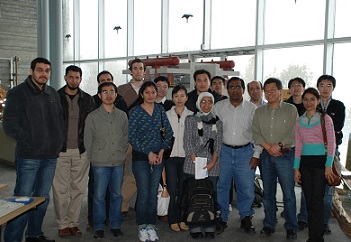
|

|
Power Management and Control to Balance Residential Microgrids with Individual Phase-wise Generation and Storage Syed Ahmed Raza Naqvi, Ph.D., 2021 Thesis Abstract The past decade has seen a significant rise in proliferation of roof-top photovoltaic (PV) systems with storage units at residential sites. This has affected the way power system engineers and researchers have previously studied distribution systems as passive networks. With the introduction of these local distributed energy resources, a distribution system has become part of an active network. This modernization of the power distribution network, brings along with itself a number of key issues that need to be pro-actively tackled by the local utilities. In North America, with family-owned roof-top PV systems, storage devices and electric vehicles, the concept of central generation has transformed to local distributed generation (DG). With this phenomenon reshaping the current perspective of distribution networks, the local generation and storage capacities, with their respective controllers, allow for these DG units to be grouped together to form single-phase microgrids most commonly referred to as residential microgrids. This thesis looks into the two key issues pertaining to residential microgrids i.e. accommodating multiple embedded generation and energy storage units while balancing the generation and loading in each phase to achieve overall three-phase system balance. A benchmark distribution system model is proposed in this thesis to study residential microgrids both in grid-connected and islanded modes. Limitations in existing distribution network models have been identified along with possible architectures for these residential microgrids. The configuration parameters of the benchmark model have been carefully selected after consultation with the London Hydro (local power utility in London, Ontario). Several case studies have been presented to show that the proposed benchmark model can be used to represent a particular architecture of the residential microgrids. Mathematical foundations of balancing residential microgrids through back-to-back converters have been developed in this thesis, which lay the foundation stone of the subsequent contributions with regards to this thesis. An online toolkit is developed in LabVIEW from the derived mathematical formulations. Two power management strategies for single-phase residential microgrids, namely intra-phase and inter-phase power management strategies have been proposed which cater for the coordinated control of these single-phase microgrids to balance generation and loading in all of the three-phases seen from a primary feeder. An operational control strategy has been later studied for optimal selection of power surplus phase(s) to mitigate the deficit(s) in other phase(s). This allows the system to transfer power from the surplus phase(s) to power deficient ones to achieve an overall balance, despite diverse load demand profiles in each phase. An experimental validation of the proposed control strategies has been carried out with laboratory-scale design and development of the back-to-back converter along side single-phase sources, loads and a control platform to mimic a typical residential microgrid. From the experimental results, it is concluded that phase imbalance can be mitigated by the transfer of surplus power from a phase to the power deficit phase. This work on power balancing single-phase residential microgrids can potentially open up new areas of research in the field of microgrids, especially with an unprecedented growth of roof-top PV panels. |
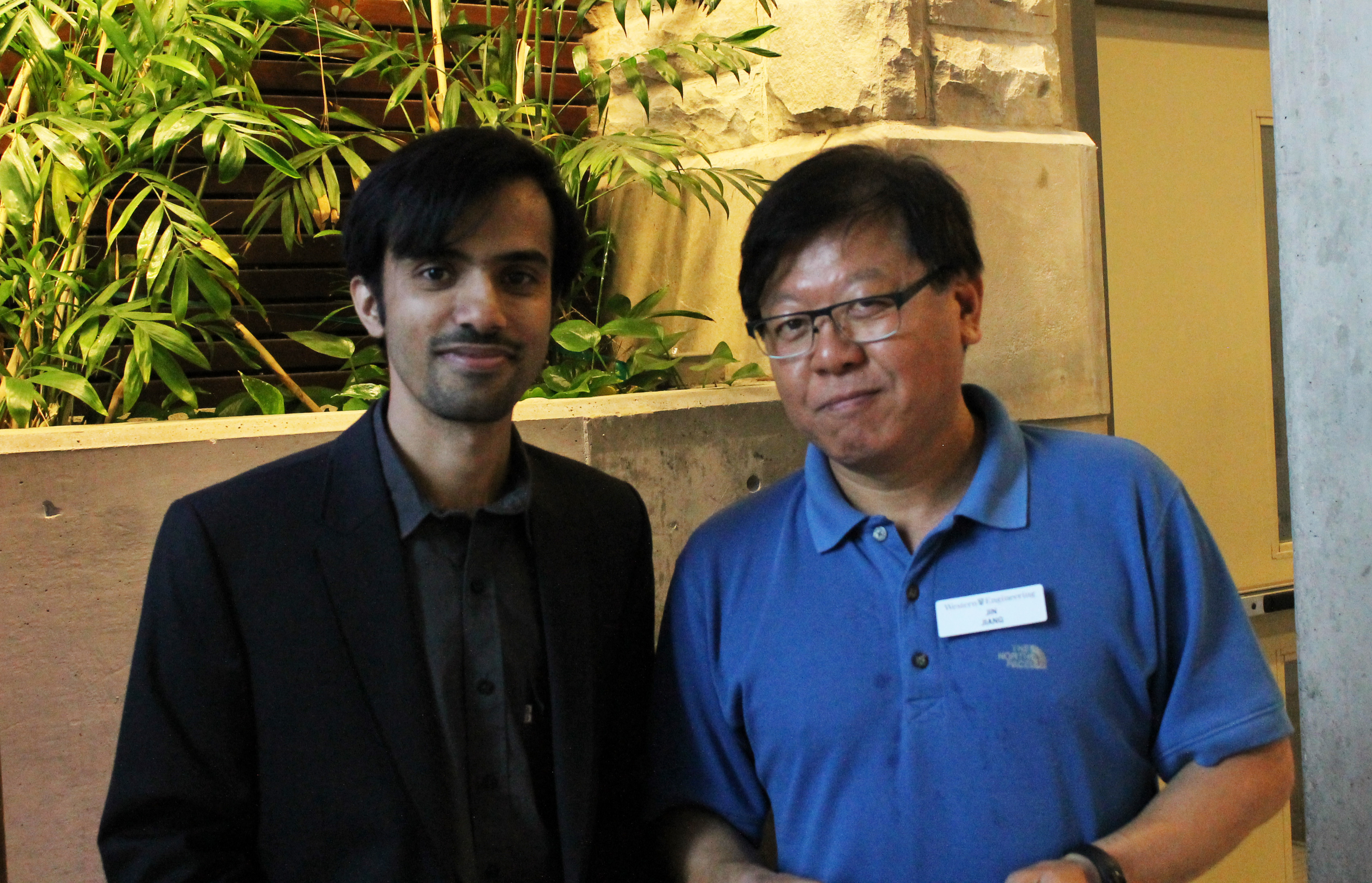
|

|
Analysis, Design and Demonstration of Control Systems Against Insider Attacks in Cyber-Physical Systems Xirong Ning, Ph.D., 2019 Thesis Abstract This dissertation aims to address the security issues of insider cyber-physical attacks and provide a defense-in-depth attack-resilient control system approach for cyber-physical systems. Firstly, security analysis for cyber-physical systems is investigated to identify potential risks and potential security enhancements. Vulnerabilities of the system and existing security solutions, including attack prevention, attack detection and attack mitigation strategies are analyzed. Subsequently, a methodology to analyze and mathematically characterize insider attacks is developed. An attack pattern is introduced to represent key features in an insider cyber-physical attack, which includes attack goals, resources, constraints, modes, as well as probable attack paths. Patterns for such attacks are analyzed for different attack stages. Impacts and consequences of these attacks are analyzed by using an attack tree. Stealthy conditions of insider attacks are identified through temporal and spatial analysis, respectively. On the defense side, a cross-layered detection scheme is developed to reveal stealthy insider attacks, and an attack-resilient control scheme is proposed to mitigate impacts of these attacks. The detection scheme includes a hierarchical approach by incorporating different detection methods in multiple layers to provide a defense-in-depth detection against the attacks. A model-based anomaly detection method is used to uncover the anomalies caused by temporal stealthy attacks, while a data-driven clustering detection method is used to recognized anomalies induced by spatial stealthy attacks. The attack-resilient control scheme consists of a decision logic and multiple attack-resilient controllers. The decision logic responds to the anomalies identified by the detection scheme and subsequently switches to suitable controllers. These controllers are designed to respond to these attacks and mitigate or minimize their impacts. To validate the above methodologies, a general guideline for designing an experimental security assessment platform has been developed in this dissertation. Furthermore, a modular approach is proposed to design and implement a platform to simulate various insider attacks and to evaluate corresponding defense mechanisms on a cyber-physical system. The designed platform has been implemented on a physical component based dynamic system simulator, known as Nuclear Process Control Test Facility (NPCTF). The proposed vulnerability assessment and security enhancement techniques have been validated under different insider attacker scenarios. |
|

|
Investigation of Radiation-Hardened Design of Electronic Systems with Applications to a Post-Accident Monitoring for Nuclear Power Plants Qiang Huang, Ph.D., 2019 Thesis Abstract This research aims at improving the robustness of electronic systems used-in high level radiation environments by combining with radiation-hardened (rad-hardened) design and fault-tolerant techniques based on commercial off-the-shelf (COTS) components. A specific of the research is to use such systems for wireless post-accident monitoring in nuclear power plants (NPPs). More specifically, the following methods and systems are developed and investigated to accomplish expected research objectives: analysis of radiation responses, design of a radiation-tolerant system, implementation of a wireless post-accident monitoring system for NPPs, performance evaluation without repeat physical tests, and experimental validation in a radiation environment. A method is developed to analyze ionizing radiation responses of COTS-based devices and circuits in various radiation conditions, which can be applied to design circuits robust to ionizing radiation effects without repeated destructive tests in a physical radiation environment. Some mathematical models of semiconductor devices for post-irradiation conditions are investigated, and their radiation responses are analyzed using Technology Computer Aided Design (TCAD) simulator. Those models are then used in the analysis of circuits and systems under radiation condition. Based on the simulation results, method of rapid power off may be effectively to protect electronic systems under ionizing radiation. It can be a potential solution to mitigate damages of electronic components caused by radiation. With simulation studies of photocurrent responses of semiconductor devices, two methods are presented to mitigate the damages of total ionizing dose: component selection and radiation shielding protection. According to the investigation of radiation-tolerance of regular COTS components, most COTS-based semiconductor components may experience performance degradation and radiation damages when the total dose is greater than 20 K Rad (Si). A principle of component selection is given to obtain the suitable components, as well as a method is proposed to assess the component reliability under radiation environments, which uses radiation degradation factors, instead of the usual failure rate data in the reliability model. Radiation degradation factor is as the input to describe the radiation response of a component under a total radiation dose. In addition, a number of typical semiconductor components are also selected as the candidate components for the application of wireless monitoring in nuclear power plants. On the other hand, a multi-layer shielding protection is used to reduce the total dose to be less than 20 K Rad (Si) for a given radiation condition; the selected semiconductor devices can then survive in the radiation condition with the reduced total dose. The calculation method of required shielding thickness is also proposed to achieve the design objectives. Several shielding solutions are also developed and compared for applications in wireless monitoring system in nuclear power plants. A radiation-tolerant architecture is proposed to allow COTS-based electronic systems to be used in high-level radiation environments without using rad-hardened components. Regular COTS components are used with some fault-tolerant techniques to mitigate damages of the system through redundancy, online fault detection, real-time preventive remedial actions, and rapid power off. The functions of measurement, processing, communication, and faulttolerance are integrated locally within all channels without additional detection units. A hardware emulation bench with redundant channels is constructed to verify the effectiveness of the developed radiation-tolerant architecture. Experimental results have shown that the developed architecture works effectively and redundant channels can switch smoothly in 500 milliseconds or less when a single fault or multiple faults occur. An online mechanism is also investigated to timely detect and diagnose radiation damages in the developed redundant architecture for its radiation tolerance enhancement. This is implemented by the built-in-test technique. A number of tests by using fault injection techniques have been carried out in the developed hardware emulation bench to validate the proposed detection mechanism. The test results have shown that faults and errors can be effectively detected and diagnosed. For the developed redundant wireless devices under given radiation dose (20 K Rad (Si)), the fault detection coverage is about 62.11%. This level of protection could be improved further by putting more resources (CPU consumption, etc.) into the function of fault detection, but the cost will increase. To apply the above investigated techniques and systems, under a severe accident condition in a nuclear power plant, a prototype of wireless post-accident monitoring system (WPAMS) is designed and constructed. Specifically, the radiation-tolerant wireless device is implemented with redundant and diversified channels. The developed system operates effectively to measure up-to-date information from a specific area/process and to transmit that information to remote monitoring station wirelessly. Hence, the correctness of the proposed architecture and approaches in this research has been successfully validated. In the design phase, an assessment method without performing repeated destructive physical tests is investigated to evaluate the radiation-tolerance of electronic systems by combining the evaluation of radiation protection and the analysis of the system reliability under the given radiation conditions. The results of the assessment studies have shown that, under given radiation conditions, the reliability of the developed radiation-tolerant wireless system can be much higher than those of non-redundant channels; and it can work in high-level radiation environments with total dose up to 1 M Rad (Si). Finally, a number of total dose tests are performed to investigate radiation effects induced by gamma radiation on distinct modern wireless monitoring devices. An experimental setup is developed to monitor the performance of signal measurement online and transmission of the developed distinct wireless electronic devices directly under gamma radiator at The Ohio State University Nuclear Reactor Lab (OSU-NRL). The gamma irradiator generates dose rates of 20 K Rad/h and 200 Rad/h on the samples, respectively. It was found that both measurement and transmission functions of distinct wireless measurement and transmission devices work well under gamma radiation conditions before the devices permanently damage. The experimental results have also shown that the developed radiation-tolerant design can be applied to effectively extend the lifespan of COTS-based electronic systems in the high-level radiation environment, as well as to improve the performance of wireless communication systems. According to testing results, the developed radiation-tolerant wireless device with a shielding protection can work at least 21 hours under the highest dose rate (20 K Rad/h). In summary, this research has addressed important issues on the design of radiation-tolerant systems without using rad-hardened electronic components. The proposed methods and systems provide an effective and economical solution to implement monitoring systems for obtaining up-to-date information in high-level radiation environments. The reported contributions are of significance both academically and in practice. |
|
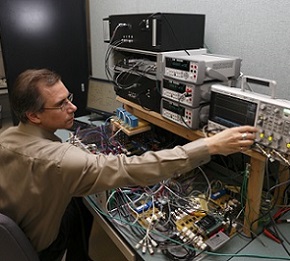
|
Predictive Energy Management of Islanded Microgrids with Photovoltaics and Energy Storage Dennis Michaelson, Ph.D., 2017 Thesis Abstract Islanded microgrids powered primarily by solar arrays present a challenging control problem due to the intermittent production and the relatively close scale between the sources and the loads. Energy storage in such microgrids plays an important role in balancing supply with demand, and in extending operation during periods when the solar resource is not available or insufficient. The efficient operation of such microgrids requires effective management of the microgrid resources. A predictive energy management strategy can potentially improve the microgrid performance and also detect and mitigate upcoming outages. This thesis presents an energy management system (EMS) for an islanded microgrid with photovoltaic generation and battery storage. The system uses a predictive approach to set operational schedules in order to (a) prolong the operation of critical system loads and (2) minimize system-wide outages, specifically through pre-emptive load shedding. Online weather forecasts are combined with the photovoltaic system model to predict energy production over a 48 hour period. These predictions, along with load forecasts and a model of the energy storage system, are used to predict the state-of-charge and characterize potential power shortages. Outage mitigation using preemptive load shedding is subsequently planned and executed to avert outages or minimize the duration of unavoidable outages. The approach features bounds on the battery state-of-charge to account for uncertainties in estimates of the stored energy. The EMS has been implemented using an event-driven framework with TCP/IP communication, which is modular and extensible. The approach has been validated through simulations and experiments. The results show that the outage durations have been reduced by a factor of 87% to 100% for the chosen operating scenarios. The impact of uncertainties in the prediction models has also been investigated, specifically for uncertainties in the photovoltaic system rating and the battery capacity. A technique is developed to compensate for such uncertainties by evaluating real-time data streams from the source and storage units. The technique is applied to the developed EMS strategy, where it is able to shorten the total outage duration by a factor of 12% for the chosen scenario. |

|

|
Predictive Shutdown Systems for Nuclear Power Plants Drew Rankin, Ph.D., 2017 Thesis Abstract
This dissertation investigates the use of a Kalman filter (KF) to predict, within the shutdown system (SDS) of a nuclear power plant (NPP), whether a safety parameter measurement will reach a corresponding trip set-point (TSP). The proposed predictive SDS (PSDS) designs aim to initiate shutdown actions at a time which is earlier than conventional shutdown initiation. These early detections are, in turn, expected to improve safety and productivity margins within the NPP. The KF-based point-PSDS design utilizes a linear time-varying (LTV) system model to predict mean safety parameter measurements for comparison against the TSP. The KF considers noise covariances that either have assumed predetermined values, or are estimated online using an adaptive limited memory filter (ALMF). The PSDS is enhanced to consider, by recursive least squares (RLS) estimation, conditions that are uncertain with respect to the assumed system model and noise properties. The result is a KF/RLS-based PSDS that compensates for prediction error by RLS-based estimation of deterministic disturbances to the system state and measurement. The PSDS is further enhanced to calculate confidence intervals for the predictions as a function of the propagated error covariance. This enhancement results in interval-PSDS designs that consider confidence in an impending condition by comparing predetermined confidence interval bounds against the TSP. Finally, an optimal-PSDS design is formulated to adapt the effective prediction, e.g. horizon or bias, by limiting and minimizing the probability of missed and false trip occurrences respectively using hypothesis testing methods and optimal alarm theory. In this manner, the optimal-PSDS is made aware of the quality of past predictions. |
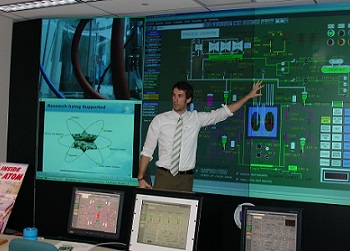
|

|
Non-linear chirp spread spectrum communication Systems of binary orthogonal keying mode Quan Wang, Ph.D., 2015 Thesis Abstract Chirp spread spectrum (CSS) is a suitable choice of modulation signals for wireless communications, due to its inherited advantages such as low transmission power, simplicity of implementation, good interference rejection capability. Linear chirps are common choices in practical CSS systems of binary orthogonal keying (BOK) mode. However, linear chirps generally require the time-bandwidth product of each chirp signal to be 60 sHz or more in order to achieve desirable orthogonality requirements. Thus, a BOK CSS system based on linear chirps has to occupy very wide bandwidth, which is a very precious resource for wireless communication. Clearly, the requirement on broad frequency bandwidth is a major limiting factor for the widespread adoption of the BOK linear CSS system in practice. To overcome this drawback, it is worthwhile to explore other types of chirp signals outside the linear domain, which can potentially reduce the bandwidth requirement without jeopardizing the system performance. This is the main objective of the current research. In this dissertation, a pair of non-linear chirps has been discovered, which has the potential to replace linear chirps for BOK CSS systems. After exploring desirable properties of non-linear chirps, it is demonstrated that a significant performance advantage on orthogonality over linear chirps can be achieved by a pair of sine or cosine chirps. Subsequently, properties of sine and cosine chirps are analyzed mathematically. Derivations of spectral characteristics, autocorrelation and cross-correlation for both sine and cosine chirps are carried out respectively. Finally, comparison of sine chirps of four different time periods (i.e. half time period, full time period, triple time period, and quadruple time period) are made in terms of their cross-correlation and autocorrelation properties. It has been concluded that full period sine (FPS) chirps are the better choice for this particular application among the sine chirps. Performance of a BOK CSS system based on FPS chirps has been evaluated in three typical scenarios. Firstly, BER (bit error rate) performance of the BOK FPS CSS system in an additive white Gaussian noise (AWGN) channel is derivated. Furthermore, performance comparison in terms of BERs between linear chirps and FPS chirps is examined. Secondly, effects of Doppler shift on the BOK FPS CSS system are analyzed. The effect of Doppler shift between linear chirps and FPS chirps has been compared. Thirdly, BER performance of the BOK FPS CSS system in a fading environment (Rayleigh channel) has been analyzed. Moreover, BER performance comparisons between linear chirps and FPS chirps in the AWGN+Rayleigh channel with and without a Doppler shift have also been studied. Using analytic means and numerical simulations, this dissertation has conclusively demonstrated that a pair of orthogonal FPS chirps has the capability of replacing linear chirp in BOK CSS systems. |

|

|
Methods and Systems for Fault Diagnosis in Nuclear Power Plants Jianping Ma, Ph.D., 2015 Thesis Abstract This research mainly deals with fault diagnosis in nuclear power plants (NPP), based on a framework that integrates contributions from fault scope identification, optimal sensor placement, sensor validation, equipment condition monitoring, and diagnostic reasoning based on pattern analysis. The research has a particular focus on applications where data collected from the existing SCADA (supervisory, control, and data acquisition) system is not sufficient for the fault diagnosis system. Specifically, the following methods and systems are developed. A sensor placement model is developed to guide optimal placement of sensors in NPPs. The model includes 1) a method to extract a quantitative fault-sensor incidence matrix for a system; 2) a fault diagnosability criterion based on the degree of singularities of the incidence matrix; and 3) procedures to place additional sensors to meet the diagnosability criterion. Usefulness of the proposed method is demonstrated on a nuclear power plant process control test facility (NPCTF). Experimental results show that three pairs of undiagnosable faults can be effectively distinguished with three additional sensors selected by the proposed model. A wireless sensor network (WSN) is designed and a prototype is implemented on the NPCTF. WSN is an effective tool to collect data for fault diagnosis, especially for systems where additional measurements are needed. The WSN has distributed data processing and information fusion for fault diagnosis. Experimental results on the NPCTF show that the WSN system can be used to diagnose all six fault scenarios considered for the system. A fault diagnosis method based on semi-supervised pattern classification is developed which requires significantly fewer training data than is typically required in existing fault diagnosis models. It is a promising tool for applications in NPPs, where it is usually difficult to obtain training data under fault conditions for a conventional fault diagnosis model. The proposed method has successfully diagnosed nine types of faults physically simulated on the NPCTF. For equipment condition monitoring, a modified S-transform (MST) algorithm is developed by using shaping functions, particularly sigmoid functions, to modify the window width of the existing standard S-transform. The MST can achieve superior time-frequency resolution for applications that involves non-stationary multi-modal signals, where classical methods may fail. Effectiveness of the proposed algorithm is demonstrated using a vibration test system as well as applications to detect a collapsed pipe support in the NPCTF. The experimental results show that by observing changes in time-frequency characteristics of vibration signals, one can effectively detect faults occurred in components of an industrial system. To ensure that a fault diagnosis system does not suffer from erroneous data, a fault detection and isolation (FDI) method based on kernel principal component analysis (KPCA) is extended for sensor validations, where sensor faults are detected and isolated from the reconstruction errors of a KPCA model. The method is validated using measurement data from a physical NPP. The NPCTF is designed and constructed in this research for experimental validations of fault diagnosis methods and systems. Faults can be physically simulated on the NPCTF. In addition, the NPCTF is designed to support systems based on different instrumentation and control technologies such as WSN and distributed control systems. The NPCTF has been successfully utilized to validate the algorithms and WSN system developed in this research. In a real world application, it is seldom the case that one single fault diagnostic scheme can meet all the requirements of a fault diagnostic system in a nuclear power. In fact, the values and performance of the diagnosis system can potentially be enhanced if some of the methods developed in this thesis can be integrated into a suite of diagnostic tools. In such an integrated system, WSN nodes can be used to collect additional data deemed necessary by sensor placement models. These data can be integrated with those from existing SCADA systems for more comprehensive fault diagnosis. An online performance monitoring system monitors the conditions of the equipment and provides key information for the tasks of condition-based maintenance. When a fault is detected, the measured data are subsequently acquired and analyzed by pattern classification models to identify the nature of the fault. By analyzing the symptoms of the fault, root causes of the fault can eventually be identified. |
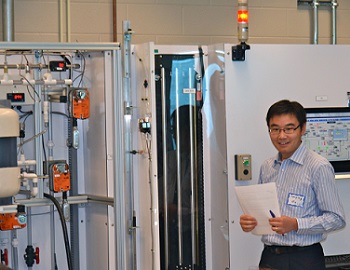
|
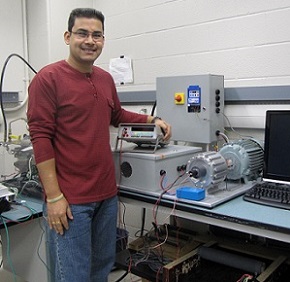
|
Power Management Strategies for a Wind Energy Source in an Isolated Microgrid Devbratta Thakur, Ph.D., 2015 Thesis Abstract This thesis focuses on the development of power management control strategies for a direct drive permanent magnet synchronous generator (PMSG) based variable speed wind turbine (VSWT). Two modes of operation have been considered: (1) isolated/islanded mode, and (2) grid-connected mode. In the isolated/islanded mode, the system requires additional energy sources and sinks to counterbalance the intermittent nature of the wind. Thus, battery energy storage and photovoltaic (PV) systems have been integrated with the wind turbine to form a microgrid with hybrid energy sources. For the wind/battery hybrid system, several energy management and control issues have been addressed, such as DC link voltage stability, imbalanced power flow, and constraints of the battery state of charge (SOC). To ensure the integrity of the microgrid, and to increase its flexibility, dump loads and an emergency back-up AC source (can be a diesel generator set) have been used to protect the system against the excessive power production from the wind and PV systems, as well as the intermittent nature of wind source. A coordinated control strategy is proposed for the dump loads and back up AC source. An alternative control strategy is also proposed for a hybrid wind/battery system by eliminating the dedicated battery converter and the dump loads. To protect the battery against overcharging, an integrated control strategy is proposed. In addition, the dual vector voltage control (DVVC) is also developed to tackle the issues associated with unbalanced AC loads. To improve the performance of a DC microgrid consisting wind, battery, and PV, a distributed control strategy using DC link voltage (DLV) based control law is developed. This strategy provides simpler structure, less frequent mode transitions, and effective coordination among different sources without relying on real-time communication. In a grid-connected mode, this DC microgrid is connected to the grid through a single inverter at the point of common coupling (PCC). The generated wind power is only treated as a source at the DC side for the study of both unbalanced and balanced voltage sag issues at a distribution grid network. The proposed strategy consists of: (i) a vector current control with a feed-forward of the negative-sequence voltage (VCCF) to compensate for the negative sequence currents; and (ii) a power compensation factor (PCF) control for the VCCF to maintain the balanced power flow between the system and the grid. A sliding mode control strategy has also been developed to enhance the overall system performance. Appropriate grid code has been considered in this case. All the developed control strategies have been validated via extensive computer simulation with realistic system parameters. Furthermore, to valid developed control strategies in a realistic environment in real-time, a microgrid has been constructed using physical components: a wind turbine simulator (WTS), power electronic converters, simulated grid, sensors, real-time controllers and protection devices. All the control strategies developed in this system have been validated experimentally on this facility. In conclusion, several power management strategies and real-time control issues have been investigated for direct drive permanent magnet synchronous generator (PMSG) based variable speed wind turbine system in an islanded and grid-connected mode. For the islanded mode, the focuses have been on microgrid control. While for the grid-connected mode, main consideration has been on the mitigation of voltage sags at the point of common coupling (PCC). |

|
|
Power Management Strategies for Islanded Microgrids Hisham Mahmood, Ph.D., 2014 Thesis Abstract The focus of this thesis is on developing power management strategies for islanded microgrids. The main objectives of the developed control strategies and the considered sources that define the scope of this work are classified based on the microgrid hierarchal control structure. This control structure subdivides the microgrid control into a primary and a secondary control layer. At the Primary Control Layer, the main objective of the proposed strategies is to achieve decentralized power management of renewable energy sources and battery storage in droop controlled microgrids. More specifically, the strategies are developed for Photovoltaic (PV) as an example for one of the common renewable energy sources. Two structural configurations for the PV and the battery storage are considered. In the first configuration, the PV and the battery storage are deployed as a single PV/battery hybrid unit in a droop controlled microgrid. Two decentralized power management strategies are proposed for this configuration. In the second configuration, the PV and the battery storage are deployed independently as separate units in the droop controlled microgrid. In contrast to the common approach of controlling the PV unit as a current source, in the proposed strategies, the PV unit is controlled as a voltage source that follows a multisegment adaptive power/frequency characteristic curve. The strategies are implemented locally at the units using multi-loop controllers without relying on a central management system and communications, as most of the existing algorithms do. Small-signal models of the proposed control loops are developed to investigate system stability. The proposed strategies are validated experimentally results on a 4 kVA prototype microgrid. At the Secondary Control Layer, strategies are developed to improve reactive power sharing in islanded microgrids. Two control strategies are proposed to achieve accurate reactive power sharing. In the proposed strategies, communication is utilized to facilitate the tuning of the proposed adaptive controllers in order to compensate for the mismatch in voltage drops across feeders. If the communication channel is disrupted, the controllers will operate with the last tuned parameters, which are shown to still outperform the conventional voltage droop control. In addition, the reactive power sharing accuracy based on the proposed strategy is immune to the time delay in the communication channel. The sensitivity of the tuned controller parameters to changes in the system operating point is also explored. The net control action of the proposed controllers is demonstrated to have a negligible effect on the microgrid bus voltage. The feasibility and effectiveness of the proposed strategies are validated using simulation and experimental results. |
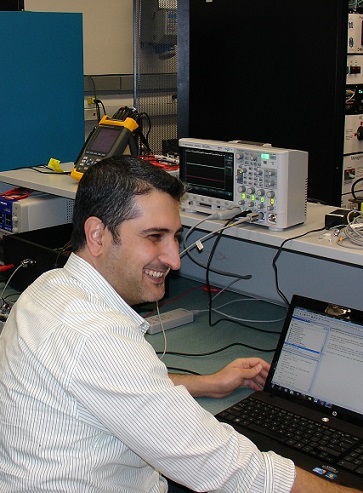
|
|
|
Investigation on the Benefits of Safety Margin Improvement in CANDU Nuclear Power Plant Using an FPGA-based Shutdown System Jingke She, Ph.D., 2012 Thesis Abstract The relationship between response time and safety margin of CANadian Deuterium Uranium (CANDU) nuclear power plant (NPP) is investigated in this thesis. Implementation of safety shutdown system using Field Programmable Gate Array (FPGA) is explored. The fast data processing capability of FPGAs shortens the response time of CANDU shutdown systems (SDS) such that the impact of accident transient can be reduced. The safety margin, which is closely related to the reactor behavior in the event of an accident, is improved as a result of such a faster shutdown process. Theoretical analysis based on neutron dynamic theory is carried out to establish the fact that a faster shutdown process can mitigate accidental consequences. To provide more realistic test cases from a thermalhydraulic perspective, an industry grade simulation tool known as CATHENA is used to generate comparable accident-shutdown transients for different SDS response times. Results from both verification methods explicitly prove the feasibility of improving the safety margin via faster shutdown process. To demonstrate this concept, a prototype of the proposed faster SDS is constructed. The trip logic of CANDU shutdown system No.1 (SDS1) is converted into a digital hardware design and implemented within chosen FPGA platform. The functionality of the FPGA-based SDS1 is implemented, and the response times are tested and compared to those of the existing CANDU SDS1. The achieved 10.5 ms response time of the FPGA-based SDS1 is again applied to the CATHENA simulation process to quantitatively present the 26.98% improvement in the safety margin. To investigate potential improvement in safety margin by using FPGA technology, hardware-in-the-loop (HIL) simulation is performed by connecting the FPGA-based SDS1 to an NPP training simulator. The 6.26% improvement in safety margin has been verified, based on which a 10% potential power upgrade is discussed as another benefit of applying FPGA technology to CANDU NPPs. |

|
|
|
Development of 3-D Neutronic Kinetic Model and Control for CANDU Reactors Lingzhi Xia, Ph.D., December 2012 Thesis Abstract The development of a three dimensional (3-D) neutronic kinetic modeling process aiming at control system design for CANadian Deuterium Uranium (CANDU) reactors is carried out in this thesis using a modal synthesis method. In this method, the reactor space-time-dependent neutron flux is synthesized by a time-weighted series of precalculated neutron flux modes. These modes are eigenfunctions of the governing neutron diffusion equation at reference steady-state operating conditions. The Xenon effect has also been considered. Special attention has been paid to compare the performance of the developed 3-D model with that of a traditional coupled point kinetic model. The 3-D reactor model is implemented by MATLAB/SIMULINK software environment. A nondimensionalized SIMULINK representation of the reactor model is established. The performance of the developed 3-D reactor neutronic kinetic model is then evaluated in a closed-loop environment with the help of a CANDU reactor regulating system (RRS) simulation platform. The dynamic behavior of the reactor model in a practical load-following mode has also been examined. The accuracy of the model has been validated against actual plant measurements under transient conditions. Through the analysis and simulation studies, it has convincingly demonstrated that the developed 3-D reactor model has significant advantages over the traditional coupled point kinetic model in terms of the improved accuracy and higher resolution in modeling the reactor internal flux behavior. Furthermore, using Graphic User Interface (GUI) techniques a user-friendly software package for the RRS simulation platform is developed. Based on the 3-D reactor model and identified deficiencies of existing RRS’ functions, an advanced 3-D reactor power distribution control is proposed and investigated. Linearization of the reactor model is performed and the performance of the linearized reactor model is evaluated in a closed-loop RRS environment. Using the feedback control law, a newly designed control strategy tries to suppress the effects of high order neutron flux modes and to emphasize behaviors of the dominant mode – the fundamental flux distribution adopted by the nominal design. Thereby, the 3-D power distribution shape during transients is optimally maintained closer to the nominal design shape than by the traditional RRS. The benefits of 3-D power distribution include not only the improved economical operation, but also improved safety as the uncertainties and the uneven power distribution are reduced. These have been confirmed by extensive simulation studies on Regional Overpower Protection (ROP) detectors’ flux transients during load following processes. |

|
|
|
Dynamic Model Construction and Control System Design for Canadian Supercritical Water-cooled Reactors Peiwei Sun, Ph.D., 2012 Thesis Abstract The dynamic characteristics of Canadian Supercritical Water-cooled Reactor (SCWR) are significantly different from those of CANDU reactors due to the supercritical water coolant and the once-through direct cycle coolant system. Therefore, it is necessary to study its dynamic behaviour and further design adequate control system. An accurate dynamic model is needed to describe the dynamic behaviour. Moving boundary method is applied to improve numerical accuracy and stability. In the model construction process, three regions have been considered depending on bulk and wall temperatures being higher or lower than the pseudo-critical temperature. Benefits of adopting moving boundary method are illustrated in comparison with the fixed boundary method. The model is validated with both steady-state and transient simulations and can predict the dynamic behaviour of the Canadian SCWR. A linear dynamic model, for dynamic analysis and control system design, is obtained through linearization of the nonlinear dynamic model derived from conservation equations. The linearized dynamic model is validated against the full order nonlinear model in both time domain and frequency domain. The open-loop dynamics are also investigated through extensive simulations. A cross-coupling analysis among inputs and outputs is examined using Relative Gain Array (RGA) and Nyquist array, from which adequate input-output pairings are identified. Crosscouplings at different operating conditions are also evaluated to illustrate the nonlinearities. It is concluded that the Canadian SCWR is a Multiple Input and Multiple Output (MIMO) system with strong cross-coupling and a high degree of nonlinearity. Due to the existence of strong cross-coupling, the Direct Nyquist Array (DNA) method is used to decouple the system into a diagonal dominance form via a pre-compensator. Three Single Input and Single Output (SISO) compensators are synthesized to the pre-compensated system in the frequency domain. The temperature variation induced by the disturbances at the reactor power and pressure has been significantly reduced. To deal with the nonlinearities, a gain scheduling control strategy is adopted. Different sets of controllers are used at different load conditions. The control strategy is evaluated under various operating scenarios. It is shown that the gain scheduling control can successfully achieve satisfactory performance for different operating conditions. |

|
|
|
A Study for Detection of Drift in Sensor Measurements Sungwhan Cho, Ph.D., 2012 Thesis Abstract This study aims to develop methods for detection of the drift in sensor measurements. The study consists of three major components; 1) residual generation, 2) statistical change detection, and 3) model building. To identify the statistical properties of the residuals and to utilize them for detection of the drift, a new method for estimation of the drift rate is proposed. The method formulates an augmented system matrix model and processes the model using a Kalman filter. An analytical method for estimation of the drift rate is also derived. A Hamiltonian approach is used for evaluation of the steady state covariance of the residuals. The steady state covariance and the estimated drift rate enable the existence of the drift in the measurements to be determined in a statistical way using the change detection algorithms. The statistical change detection algorithms process the residuals to determine the drift statistically. In the study, performance of the major algorithms, including the Exponentially Weighted Moving average (EWMA), Cumulative Sum (CUSUM) control chart, and Generalized Likelihood Ratio Test (GRLT), are investigated. A new method for detection of the change, named the “Standardized Sum of the Innovation Test (SSIT),” is also proposed. The statistical properties of the decision function of the SSIT are derived to set the decision threshold statistically. A method for estimation of the mean delay of the SSIT is also derived. The mean delay of the SSIT is shown in a demonstration and is the shortest of the change detection algorithms. For demonstration purposes, mathematical models of a pressurizer in a CANada Deuterium Uranium (CANDUR) nuclear power plant are developed. The mathematical models in the form of nonlinear differential equations are verified by comparing the simulation results with those of the industry standard code called “CATHENA” (Canadian Algorithm for Thermal Hydraulic Network Analysis). The developed algorithms have been successfully applied to the pressurizer model for detection and estimation of pressure sensor drifts. The results convincingly demonstrate the effectiveness of the proposed algorithms in the detection of the drift. |

|
|
|
Measurement of Dynamic Temperatures and Pressures in Nuclear Power Plants Hashem Mehrdad Hashemian, Ph.D., 2011 Thesis Abstract The dynamic response of the process sensors that supply real-time data to the safety systems in nuclear power plants (NPP) plays a vital role in preventing plant accidents. If a critical process temperature, pressure, level, or flow experiences a step change, for example, the sensors that measure the process variable must act quickly to actuate the safety systems that will mitigate the consequence of an undesirable process excursion. The research conducted for this dissertation has been performed to ensure the prompt response of critical sensors by advancing, refining, validating, and implementing new methods for measuring the response time of temperature, pressure, level, and flow sensors in NPP safety systems. The essential significance of the new methods is that they can be performed remotely on installed sensors at operating conditions, thereby providing the actual in-service response time as opposed to the unrealistic response time provided by the manufacturer or by offline testing. The in-situ response time testing technique for temperature sensors is referred to as the Loop Current Step Response (LCSR) test. This technique is based on heating the sensor internally by applying a step change in the DC current to the sensor extension leads in the plant control room. The DC current heats the sensing element of the sensor, resulting in a temperature transient that is then analyzed to provide a true sensor response time, which accounts for all process conditions as well as for the effects of installation and aging. This dissertation presents the theoretical foundation of the LCSR, the details of the author’s extensive experimental research to validate and refine its use in multiple nuclear plant safety applications, and the assumptions that support the validity of the author’s research and experimental results. The in-situ response time testing technique for pressure, level, and flow transmitters is the so-called noise analysis method. This method is based on recording and analyzing the inherent process fluctuations present at the output of transmitters while the plant is operating. These fluctuations (noise) arise from random flux, turbulent flow, random heat transfer, process control action, and vibration. They are separated from the output of the transmitter by signal conditioning, recorded for about an hour, and analyzed in frequency and/or time domain to yield the response time of the pressure sensing system. This dissertation describes the theoretical foundation of the noise analysis technique, the details of the experimental research that the author has conducted for this dissertation to validate and expand the scope of this technique in actual plant applications, and the assumptions informing the author’s confidence that the research in this dissertation validates the noise analysis technique. The significance of the noise analysis technique is that it not only measures the in-service response time of the transmitter but also of its sensing lines. In contrast to other methods, it can thereby account for the effect of sensing-line length, blockages, and voids on sensor response time. As part of this research, both the LCSR and noise analysis techniques were validated through extensive laboratory measurements performed on temperature and pressure sensors of the types used in nuclear power plants. The author has used these results to indicate where these methods are most effective but also where they may pose significant uncertainties or may fail. In general, this research has concluded that the LCSR method can identify the response time of RTDs with better than 90 percent accuracy and that the noise analysis technique provides response time results for pressure transmitters to better than 80 percent accuracy. This is provided that the RTDs and pressure transmitters tested meet the assumptions that must be satisfied in the design of the sensors and the conditions of the tests. |

|
|
|
Low-Power Chirp Signals for Wireless Data Communication in Industrial Environment Abdullah Kadri, Ph.D., 2009 Thesis Abstract A class of wideband chirp (linear FM) signals, called M-ary Chirp Spread Spectrum (MCSS) modulation, is proposed for wireless data transmission in industrial environments that have strict regulations of radiated power from electronic devices, systems, etc. such as in nuclear power plants. The MCSS modulation is described and the resulting signals are illustrated as a function of modulation parameters. The electromagnetic interference (or noise) in industrial environments is predominantly impulsive in character and is modeled as non-Gaussian statistical distribution. The dissertation consists of two parts. In the first part, optimal low-SNR receivers are derived for coherent and non-coherent detections of MCSS signals in arbitrary additive, white, non-Gaussian interference. These receivers consist of zero-memory nonlinearity (ZMNL), -d/dr lnPw(r) , where Pw(r) is the first-order noise density, followed by corresponding coherent and non-coherent Gaussian receivers. Asymptotic bit error rate (BER) performance bounds of these receivers are derived and illustrated as functions of: i) Signal-to-Noise Ratio (SNR), ii) Modulation parameters; iii) Parameters of first-order noise density; and iv) Detection sample size. Optimal coherent MCSS modulations that minimize BER performance have been determined and illustrated. Sensitivity of optimal low-SNR receivers to uncertainties in the estimation of noise density parameters is examined, and it is found that these receivers are nearly optimal over a wide range of noise density parameters of practical interest. Also, three easy-to-implement suboptimal receivers are considered and their relative performances to that of the optimal receiver are evaluated. Finally, an investigation of error rate performance of coherent low-SNR receivers for Bose-Chaudhuri-Hocquenghem (BCH) coded MCSS modulation is carried out and performance trade-offs between coding and modulation are highlighted. Three well-known non-Gaussian noise models that represent real-world noise environments are used in this study to illustrate performance results. A comparison of error rate performance of MCSS modulation with that of conventional modulations, with and without BCH coding, is also provided. In the second part of the dissertation, experimental characterization of wireless sensor networks (WSNs) is carried out in indoor and industrial environments in the presence of coexisting electromagnetic interference (EMI) on the 2.4 GHz industrial, scientific, and medical (ISM) band. The first WSN uses CSS modulation and the second uses offset-quadrature phase shift keying (O-QPSK) modulation. The performance is evaluated for a point-to-point topology with the following three scenarios: i) when coexisted with other wireless systems, ii) under time-varying EMI, and iii) when the system is deployed in harsh industrial environment. In these evaluations, the transmission power levels are very low in the range from 0dBm to -28.9dBm. The performance metrics used are: i) packet loss rate; ii) packet error rate; iii) bit error rate; and iv) throughput. The results obtained are particularly applicable in the development of low-power and high-reliability wireless network systems in industrial environments in which communication systems are required to meet strict regulations in terms of radiated power. |
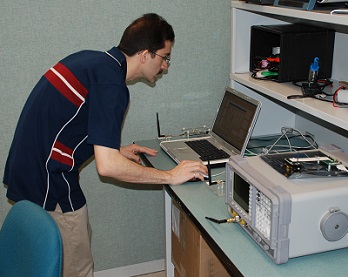
|
|
|
Modeling and Simulation of CANDU Reactor and Its Regulating System Hooman Javidnia, Ph.D., 2009 Thesis Abstract Analytical computer codes are indispensable tools in design, optimization, and control of nuclear power plants. Numerous codes have been developed to perform different types of analyses related to the nuclear power plants. A large number of these codes are designed to perform safety analyses. In the context of safety analyses, the control system is often neglected. Although there are good reasons for such a decision, that does not mean that the study of control systems in the nuclear power plants should be neglected altogether. In this thesis, a proof of concept code is developed as a tool that can be used in the design, optimization, and operation stages of the control system. The main objective in the design of this computer code is providing a tool that is easy to use by its target audience and is capable of producing high |